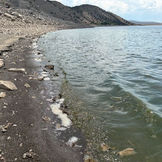Harmful Cyanobacterial Blooms (HCBs)
Harmful Cyanobacterial Blooms (HCBs), also known as Harmful Algal Blooms (HABs), are dense concentrations of cyanobacteria (although once classified as and often still referred to as blue-green algae due of their photosynthetic ability, cyanobacteria are in fact bacteria) in waterbodies. Waterbodies contaminated with these cyanobacterial blooms pose a health risk to people (illness) and animals (possible death) that have direct contact with contaminated water (swimming, drinking, breathing aerosols).
HCBs typically develop in mid to late summer and can occur in flowing and non-flowing waters such as steams, rivers, lakes, and reservoirs. HCBs may be green, tan, brown, or blue-green in color. HCBs may float in or on the water and look like spilled paint, grass clippings, clumps, or scums. They may also be attached to aquatic plants, rocks, or other material and look like films, mats, or gelatinous balls.
You cannot tell if a cyanobacterial bloom is toxic by looking at it. The best way to protect yourself, your family, and your pets is to be aware of HCBs in Wyoming waters and stay away from any water with signs of an HCB. Do not let your animals drink, swim or eat near discolored or scummy water, and keep them from licking their fur, eating dead fish or animals found near an HCB, or eating HCB material.
The following are some resources on HCBs/HABs to keep yourself and your animals safe.
We have also included some pictures of a bloom below.
Resources
The Wyoming DEQ has a website with advisories and resources to keep you and your animals safe:
Advisories and investigations for 2025
Educational Materials for Wyoming HCBs (pdfs):
The USDA Natural Resource Conservation Service has a webpage dedicated to providing information to help you protect your livestock from Harmful Algal Blooms (HABs):
Bloom Photos




.png)













